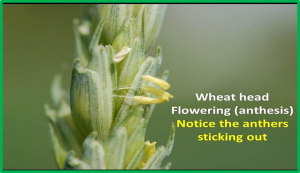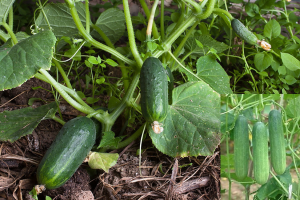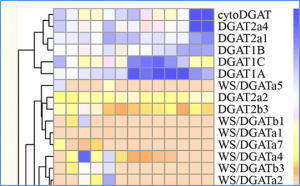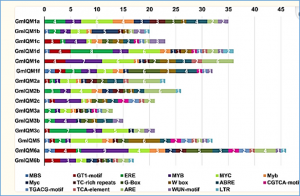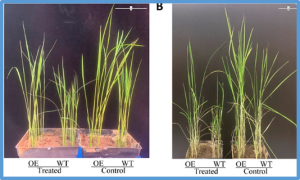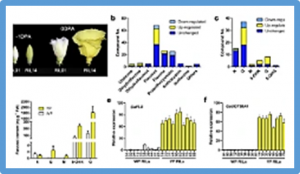Rust is a devastating disease in sunflower that is damaging to the sunflower production globally. Identification and utilization of host-plant resistance are proven to be preferable means for disease control. The rust resistance gene R12 with broad-spectrum specificity to rust was previously localized to a 2.4 Mb region on sunflower chromosome 11. To understand the molecular mechanism of resistance, we conducted whole-genome sequencing of RHA 464 (R12 donor line) and reference genome-based fine mapping of the gene R12.
Heading date (HD) is a complex quantitative trait that determines the regional adaptability of cereal crops, and identifying the underlying genetic elements with minor effects on HD is important for improving wheat production in diverse environments. In this study, a minor QTL for HD that we named Qhd.2AS was detected on the short arm of chromosome 2A by Bulked Segregant Analysis and validated in a recombinant inbred population.
Crop disease represents a serious and increasing threat to global food security. Lanthanum oxide nanomaterials (La2O3 NMs) with different sizes (10 and 20 nm) and surface modifications (citrate, polyvinylpyrrolidone [PVP], and poly(ethylene glycol)) were investigated for their control of the fungal pathogen Fusarium oxysporum (Schl.) f. sp cucumerinum Owen on six-week-old cucumber (Cucumis sativus) in soil.
The use of alkaline salt lands for crop production is hindered by a scarcity of knowledge and breeding efforts for plant alkaline tolerance. Through genome association analysis of sorghum, a naturally high-alkaline-tolerant crop, we detected a major locus, Alkaline Tolerance 1 (AT1), specifically related to alkaline-salinity sensitivity. An at1 allele with a carboxyl-terminal truncation increased sensitivity, whereas knockout of AT1 increased tolerance to alkalinity in sorghum, millet, rice, and maize. AT1 encodes an atypical G protein γ subunit that affects the phosphorylation of aquaporins to modulate the distribution of hydrogen peroxide (H2O2).
Here, we identified soybean DGAT genes via a bioinformatics method, thereby laying a solid foundation for further research on their function. Based on our bioinformatics analyses, including gene structure, protein domain characteristics, and phylogenetic analysis, 26 DGAT putative gene family members unevenly distributed on 12 of the 20 soybean chromosomes were identified and divided into the following four groups: DGAT1, DGAT2, WS/DGAT, and cytoplasmic DGAT.
IQM, a plant-specific calmodulin-binding protein, plays multiple roles in plant growth and development. Although a comprehensive analysis has been carried out on the IQM family genes in Arabidopsis and rice, the number and functions of IQM genes in other species have not been explored. In this study, we identified 15 members of the soybean (Glycine max) IQM gene family using BLASTP tools.
Transcription factors (TFs) play critical roles in mediating the plant response to various abiotic stresses, particularly heat stress. Plants respond to elevated temperatures by modulating the expression of genes involved in diverse metabolic pathways, a regulatory process primarily governed by multiple TFs in a networked configuration. Many TFs, such as WRKY, MYB, NAC, bZIP, zinc finger protein, AP2/ERF, DREB, ERF, bHLH, and brassinosteroids, are associated with heat shock factor (Hsf) families
Petal color is pivotal to ornamental value and reproduction of plants. Yellow coloration in plant petals is mainly attributed to colorants including carotenoids, aurones and some flavonols. To date, the genetic regulatory mechanism of flavonol biosynthesis in petals is still to be elucidated. Here, we employed Asiatic cottons with or without deep yellow coloration in petals to address this question.
‘Thatcher’ wheat near isogenic line RL6149, a putative derivative of Triticum dicoccoides, was previously determined to carry leaf rust resistance gene Lr64 on chromosome arm 6AL and a second gene temporarily named LrX on chromosome arm 1DS. The objective of this study was to map and characterize LrX in a population of recombinant inbred lines (RILs) that segregated for a single gene.
Crop biofortification is a successful strategy to ameliorate Vitamin A deficiency. Sorghum is a good candidate for vitamin A biofortification, as it is a staple food in regions with high prevalence of vitamin A deficiency. β-carotene-the main provitamin A carotenoid-is below the target concentration in sorghum grain, therefore biofortification breeding is required. Previous studies found evidence that sorghum carotenoid variation is oligogenic, suggesting that marker-assisted selection can be an appropriate biofortification method. However, we hypothesize that sorghum carotenoids have both oligogenic and polygenic components of variation.


 Curently online :
Curently online :
 Total visitors :
Total visitors :

